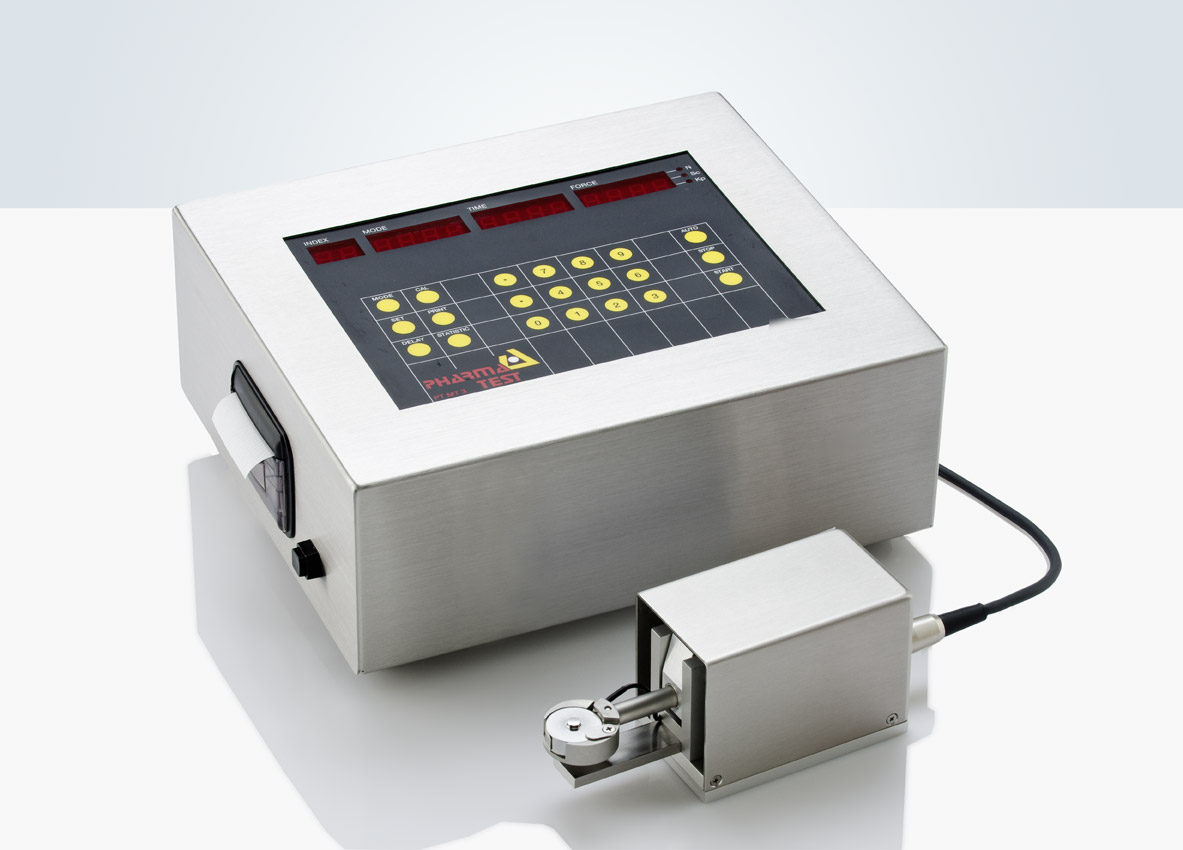PTB 311E / 511E / 311E-800
Manual 3-in-1 Tablet Testing Instrument
The manual tablet testing instrument PTB 311E/511E/311E-800 is a dual force mode hardness test apparatus as it can be used for either linear force or linear speed increase while tablet hardness is tested. It offers a multiple point validation procedure for the built-in digital load cell. The instrument is made in strict compliance with the EP <2.9.8> and USP <1217> Pharmacopoeia.
PTB 311E / 511E / 311E-800
Manual 3-in-1 Tablet Testing Instrument
The manual tablet testing instrument PTB 311E/511E/311E-800 is a dual force mode hardness test apparatus as it can be used for either linear force or linear speed increase while tablet hardness is tested. It offers a multiple point validation procedure for the built-in digital load cell. The instrument is made in strict compliance with the EP <2.9.8> and USP <1217> Pharmacopoeia.
Test Procedure
Enter the nominal test information for thickness, diameter or length and hardness as well as a batch number via the PTB 311E/511E/311E-800 keyboard. Select the units to measure, mm – Inch, KP (Kilopond), N (Newton) or Sc (Strong Cobb). Now place the sample onto the sample upright in to the Thickness Jaw and start the test. The driven jaw will run forward, touch and force the tablet at its highest point to measure the thickness, thereafter it reverses back so that the sample falls into horizontal position to test its diameter (length) and immediately its hardness (tablet breaking force). The 3 result are immediately displayed and printed to a connected dot-matrix or suitable PCL5 type laser- or Deskjet printer.
Repeat this until your series has been tested, get a full print-out including each individual result, date, time, serial number of the instrument, batch number of the product tested, mean value and deviations of the test series. In case you need to test hardness “only”, no problem; zero Thickness and Diameter station and perform hardness tests only. This flexibility and the reproducibility of the results have made the PTB 311E/511E/311E-800 series to become one of the most sold hardness testers. The flexibility and the reproducibility of the results have made this and other models, like the PTB111E/EP&PTB111E/EP-500&PTB111E/EP-800 series to become one of the most sold tablet hardness testing instruments worldwide.
Operating Principle
Even in the existing USP and EP monographs there is no standard force setting or force increase mode established, but it is recommended to use a linear force increase rate of 20N/s. Different force settings usually cause problems when comparing results received by different supplier’s instruments when testing the same tablet. The hardness result is directly influenced by the contact speed and force increase rate.
Faster operated test jaw means lower reproducibility and often higher results. In order to offer the possibility to select an operating mode which will offer you similar results as the instruments you may already use, select the force mode, linear force increase or linear speed increase and select the same or similar rate. Also touch and detection force may be altered to suit the sample design specification. When the sample is touched the instrument switches to the selected mode and linear increasing rate.
Which Force Mode Should Be Selected?
For more than 18 years all Pharma Test hardness testing instruments offer the possibility to select either linear force or linear speed increase. Linear force increase is the recommended setting as it offers the most accurate control, as the rate of increase is directly controlled by the electronic load cell used to read the force. Also it is quite simple to validate the correct and linear operation as a tablet having a hardness of 100 Newton will be broken within 5 seconds if 20N/s had been set as force increase rate. The test of “soft” tablets often requires an increase of the standard force setting, otherwise the sample gets deformed only but does not break. Linear speed increase can also be used. Here the driving speed of the motor is kept linear. Actually if the touching force is kept low there is not too much difference in results between the two systems but it is very difficult to validate the linearity of the drive speed.
Calibration and Validation
The current USP Pharmacopeia requires the force sensor of a tablet hardness testing instrument to be calibrated periodically over the complete measuring range (or the range used for measuring samples) with a precision of 1N. All Pharma Test tablet hardness testing instrument can be statically calibrated over the complete measuring range by the use of different traceable counterweights. All instruments support the checking of at least three different points during calibration to prove the linearity of the force sensor.
For the thickness and diameter station, certified reference blocks are used for both calibration and adjustment. Weight sets are used to calibrate and adjust the force sensor (load cell) of the instrument over the complete measuring range. For the two point adjustment (zero and reference) of the load cell inside the hardness station a certified reference weight of 10 kg is used. For validation purposes the use 5 up to 30kg certified weights is recommended. All adjustment and calibration results can be printed and countersigned.
To prove the linearity of the instrument, the operator can program a print-out of the force curve recorded during a test. This will show the linear increase of the adjusted force mode. Also different weights, like the PTB-CAL15 and PTB-CAL30 weight sets which include 5, 10, 15kg and 30kg (PTB-CAL30) using two additional 10kg weights for total 50kg, may be placed onto the load cell or the PT-MT and can be used to validate the linearity. Using the parallel port a Matrix or PCL5 printer can be added and using the RS232 COM port, all results can be transmitted to software running on a computer system.



